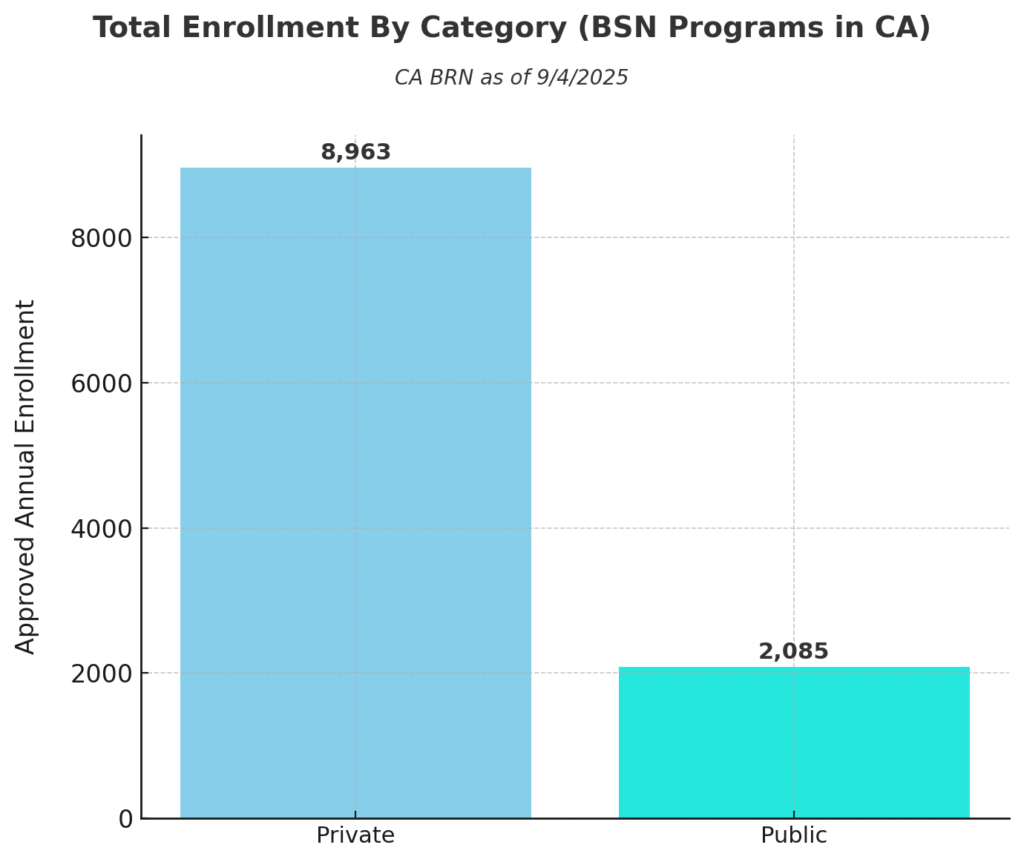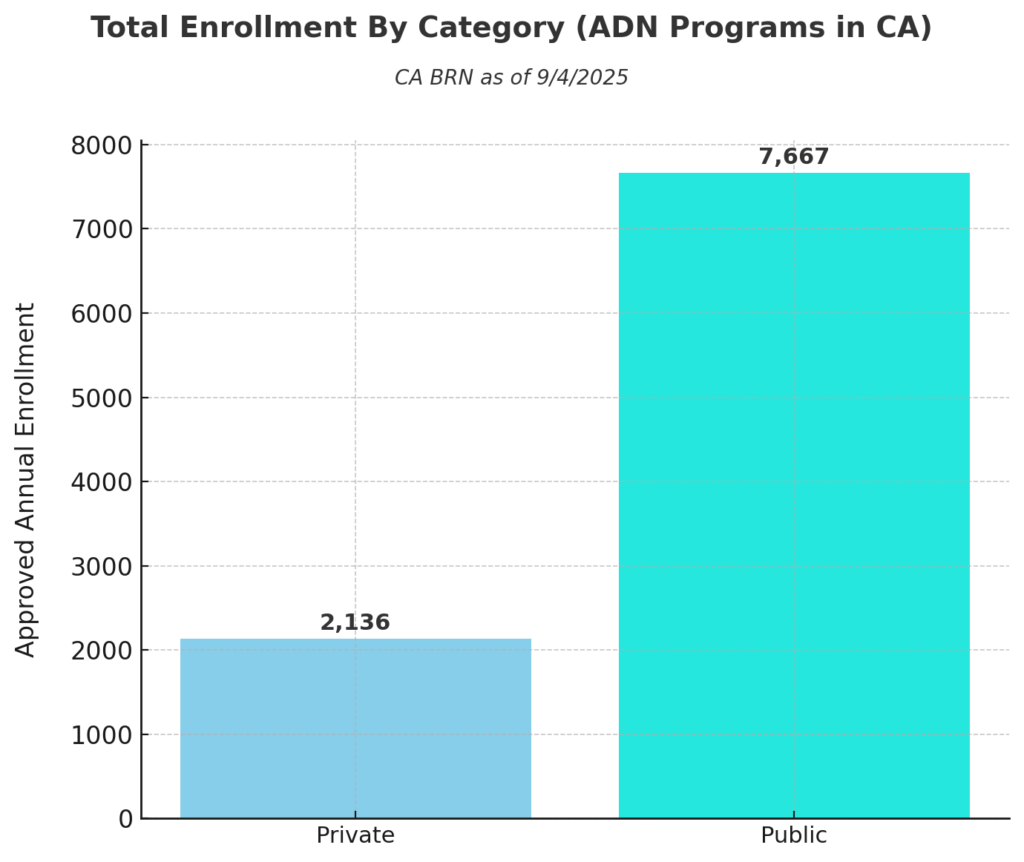Did you know that 80% of students enrolling in a BSN pre-licensure program in California choose a private nursing school? That’s the latest data by California’s Board of Nursing, a trend that has been consistent over the last decade. So, what’s behind this phenomenon and why are so many pre-nursing students turning to private nursing programs?
In this blog, we’ll break down the latest enrollment data and explore the top five reasons why private nursing schools in California have become a preferred choice.
Acceptance Rate
To understand the rising popularity of private nursing programs in California, it’s important to first consider the accessibility challenges within public institutions. UC and CSU nursing programs accept just 10% of qualified applications each year at the BSN pre-licensure level. In contrast, private nursing schools offering the same degree have a 62% acceptance rate. Private institutions also offer 3.5x more BSN seats than public programs.
To put these numbers into perspective, the UCLA nursing program acceptance rate is just 1% for incoming freshman and 7% for transfer students. SDSU nursing acceptance rate is 5% for incoming freshman and hovers near 10% for transfer students. Things are just as tight in Northern California where San Francisco State University nursing (SFSU) acceptance rate is 6%. Despite this, UC and CSU nursing programs continue to receive nearly twice as many applications each year compared to private programs.
A similar trend can be seen at the ADN level, where public community colleges in California accept just 28.5% of qualified applications, compared to 69% at private ADN programs. The biggest difference here is that public community colleges offer significantly more seats, allowing community colleges to educate a larger share of ADN students across the state.


Ultimately, pre-nursing students in California are facing extreme impaction and are finding private BSN nursing programs to be a more accessible alterative with higher acceptance rates and more seats available.
The Admissions Experience
The way nursing programs select candidates plays a key role in why students opt for private nursing programs over public ones. With less student impaction, private nursing schools typically offer a more predictable and straightforward enrollment process compared to the lottery and point-based systems used in public schools.
Direct Entry Advantages
Direct-Entry nursing programs in California are found mostly at private nursing schools. These programs offer a level of predictability that many students favor. That’s because students are selected as long as they meet the minimum admissions criteria. The admissions selection process at public institutions couldn’t be more different.
Lottery System
Many public nursing schools in California select students through a lottery. Students who meet the minimum admissions requirements are randomly selected and offered a seat. A Northern California nursing program that uses the lottery system describes its process this way:

“The ADN program uses a lottery system to select qualified candidates for admission. Some students are admitted the first time they apply, and some students end up applying for several years. It is really a matter of luck so there is no way to project how long it will take you to get into the program.”
In essence, even if students go well beyond the minimum admission requirements, their chances of being accepted will be the same as a candidate who achieved the minimum standard.
Point-System
Other public nursing schools use a point-based or multi-criteria system to determine admissions, granting spots to students who accumulate the highest number of points across various factors. These factors can include academic achievements like GPA and entrance exam scores, as well as non-academic criteria such as work experience, medical licenses, and community service.
While academic performance plays a role, impaction often leads to a bottleneck of overqualified applicants. When students aren’t accepted, they are incentivized to earn additional credentials to strengthen their applications for the next admissions cycle. As they reapply with more experience and points, they gain an advantage over the traditional pre-nursing students who lack work experience or medical licenses. This cycle continues, making it even more difficult for first-time applicants to secure a spot.
Equity initiatives also influence some point-based systems, with extra points awarded for factors such as low family income, refugee status, first-generation college attendance, or proficiency in languages other than English. While these policies aim to promote diversity, they can also make the admissions process more competitive and complex for students who do not qualify for these additional points.
Transfer Friendly
Students enrolling at private nursing schools in California often use transfer credits earned from community colleges or CSU/UC campuses. This is especially helpful for those who originally planned to attend public nursing programs but pivoted to private options due to impaction. In most cases, private and public nursing programs have similar prerequisite requirements, which makes the transition to the private route smoother. This ultimately helps students avoid delays and added expenses for having to retake courses.
Rolling Admissions
Many private nursing schools in California offer rolling admissions, accepting students on a first-come, first-served basis. These programs typically provide two to four start dates per year, giving students greater flexibility to complete their general education and prerequisites without the pressure of strict deadlines.
In contrast, public nursing programs often offer only one to two start dates annually, with application deadlines set six to ten months in advance. Missing these deadlines can lead to significant delays in a student’s academic timeline.
NCLEX Pass Rates
Strong NCLEX pass rates may be another reason students are choosing to complete their nursing degrees at private schools. Many private programs have first-time NCLEX pass rates that align with national trends. The California Board of Registered Nursing publishes this data each year, allowing students to use the data as part of their decision-making process.
While public nursing programs in California often report higher NCLEX pass rates, that may be partly because they admit some of the most competitive applicants. Private programs, on the other hand, are more likely to give a great share of qualified students an opportunity, even if they aren’t 4.0 students.
Final Thoughts
Private nursing programs in California have become a popular choice due to higher acceptance rates, rolling admissions, multiple start dates, and transfer-friendly policies. With public nursing programs in California facing capacity challenges, many students turn to private nursing schools for a more accessible and predictable path to nursing.


